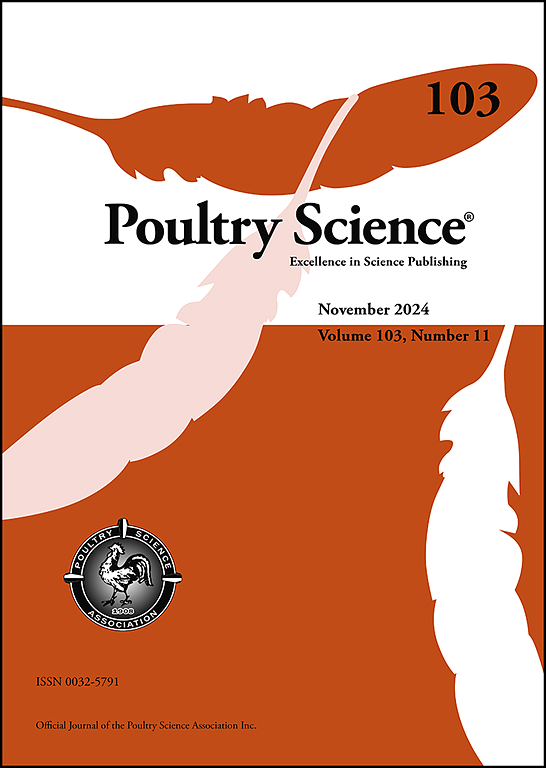The interplay of oxytocin and dopaminergic system: Effects on food consumption in broiler chickens
IF 3.8
1区 农林科学
Q1 AGRICULTURE, DAIRY & ANIMAL SCIENCE
引用次数: 0
Abstract
Oxytocin play a crucial physiological role in regulating feed consumption and maintaining energy homeostasis. Numerous studies have highlighted the influence of central dopaminergic systems on appetite control; however, there is a lack of information regarding their interaction with food intake regulation in avian species. Consequently, the present study aimed to investigate the potential interplay between the central oxytocin and dopaminergic systems in modulating food consumption in broiler chicks. In the initial experiment, various doses of oxytocin (2.5, 5, and 10 µg) and saline were administered via intracerebroventricular (ICV) injection to ascertain the effective dosage of oxytocin. The second experiment involved ICV injections of saline, SCH23390 (a D1 receptor antagonist), the identified effective dose of oxytocin, and a co-injection of SCH23390 with oxytocin. Subsequent experiments (3 to 7) followed a similar methodology, substituting SCH23390 with AMI-193 (a D2 receptor antagonist), NGB2904 (a D3 receptor antagonist), l-741,742 (a D4 receptor antagonist), 6-hydroxydopamine (a dopaminergic neurotoxin), and l-DOPA (a dopamine precursor), respectively. Cumulative food intake was measured over a period of 120 min post-injection. The findings revealed that ICV administration of oxytocin significantly reduced feed consumption in broilers compared to the control group (P < 0.05). Additionally, the co-infusion of SCH23390 and 6-hydroxydopamine alongside oxytocin significantly mitigated the hypophagic effect induced by oxytocin (P < 0.05). In contrast, AMI-193, NGB2904, l-741,742, and l-DOPA did not exhibit any significant influence on oxytocin-induced hypophagia (P ≥ 0.05). These findings suggest that the anorexigenic effect of oxytocin may be primarily mediated through D1 dopaminergic receptors in broilers.

求助全文
约1分钟内获得全文
求助全文
来源期刊

Poultry Science
农林科学-奶制品与动物科学
CiteScore
7.60
自引率
15.90%
发文量
0
审稿时长
94 days
期刊介绍:
First self-published in 1921, Poultry Science is an internationally renowned monthly journal, known as the authoritative source for a broad range of poultry information and high-caliber research. The journal plays a pivotal role in the dissemination of preeminent poultry-related knowledge across all disciplines. As of January 2020, Poultry Science will become an Open Access journal with no subscription charges, meaning authors who publish here can make their research immediately, permanently, and freely accessible worldwide while retaining copyright to their work. Papers submitted for publication after October 1, 2019 will be published as Open Access papers.
An international journal, Poultry Science publishes original papers, research notes, symposium papers, and reviews of basic science as applied to poultry. This authoritative source of poultry information is consistently ranked by ISI Impact Factor as one of the top 10 agriculture, dairy and animal science journals to deliver high-caliber research. Currently it is the highest-ranked (by Impact Factor and Eigenfactor) journal dedicated to publishing poultry research. Subject areas include breeding, genetics, education, production, management, environment, health, behavior, welfare, immunology, molecular biology, metabolism, nutrition, physiology, reproduction, processing, and products.
 求助内容:
求助内容: 应助结果提醒方式:
应助结果提醒方式:


